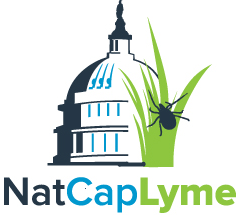|
|
P.O. Box 8211, McLean, VA 22106-8211 • Phone & Fax 703-821-8833 • NatCapLyme@natcaplyme.org
Virginia Senate Passes Landmark Lyme Disease Bill
NatCapLyme Urges the House of Delegates to Follow Suit
(McLean, VA) – February 11, 2016 – The National Capital Lyme Disease Association (NatCapLyme) today announced that the Virginia Senate passed landmark legislation relating to a patient’s right to treatment under guidelines listed in the National Guidelines Clearinghouse (the “NGC”).
Lyme can be tremendously debilitating, leading to loss of livelihood and even normal daily functioning. Lyme patients are desperate for treatment options. Increasingly, however, Virginia doctors are refusing new patients who present with the symptoms of Lyme or other tick-borne diseases. Where it appears that a patient may require extended antibiotic treatment beyond the standard 28 days, many Virginia doctors believe that reporting and treating these cases can lead to sanctions from the Virginia Board of Medicine.
Understandably, physicians do not want to risk exposure to such sanctions, despite the fact that extended treatment is suggested under at least one NGC published guideline. SB-671 provides that when a patient chooses to accept treatment in accordance with a clinical practice guideline maintained by the NGC, a health care provider will not be subject to health regulatory board investigations or hearings based solely on the decision to follow such clinical practice guideline.
The NGC is an initiative of the U.S. Department of Health and Human Services, in partnership with the American Medical Association and the American Association of Health Plans. Housed in the Agency for Healthcare Research and Quality, its mission is to provide health professionals with objective information on clinical practice guidelines and to further the dissemination and use of such guidelines.
The purpose of this legislation is simply to ensure that – when expert criteria published by the NGC have been sufficiently met – medical practice in accordance with that guideline should not, alone, lead to physician discipline.
“Lyme disease has reached epidemic proportions in Virginia,” says NatCapLyme Executive Director Monte Skall. “Many Virginians with Lyme disease cannot get the medical assistance they need to adequately deal with the disease. We thank Senator Dick Black (R-13) for introducing this bill and shepherding it through the Senate. Additionally, we are extremely grateful to Senator Bryce Reeves (R-17) for his support and compelling floor speech. We also want to thank all the Virginia Lyme disease sufferers and their families for their support and assistance in bringing their stories to their senators to help get this bill passed. Now, it’s on to the Virginia House of Delegates. The job is not done!”
The National Capital Lyme Disease Association is an organization with over 3,000 members, including fifteen chapters throughout the District of Columbia, Virginia, Maryland, and North Carolina. Its mission is to improve the quality of life for people suffering from Lyme and other tick-borne illnesses by offering support and disseminating information that educates and empowers patients, families, healthcare workers, and the community at large about these diseases.
The U.S. Centers for Disease Control (the “CDC”) considers Lyme disease to be the fastest spreading tick-borne disease in the U.S. with an estimated 329,000 new cases each year. Just this week, scientists discovered a second bacterium that causes Lyme disease, named Borrelia mayonii. The latest CDC statistics also report that Virginia is among the top-10 Lyme disease states.
Below is a record of yesterday’s Virginia Senate vote:
YEAS–Alexander, Black, Carrico, Chafin, Chase, Cosgrove, Dance, DeSteph, Edwards, Garrett, Hanger, Howell, Marsden, McPike, Newman, Obenshain, Reeves, Ruff, Stuart, Sturtevant, Surovell, Vogel, Wagner, Wexton–24.
NAYS–Barker, Deeds, Dunnavant, Ebbin, Favola, Lewis, Locke, Lucas, McDougle, McEachin, Miller, Norment, Petersen, Saslaw, Suetterlein–15.
NOT VOTING–Stanley–1.
For more information about Lyme disease or this bill, please contact Monte Skall at 703-821-8822 or visit the NatCapLyme website at http://www.natcaplyme.org/, Facebook and Twitter at NatCapLyme.
|






